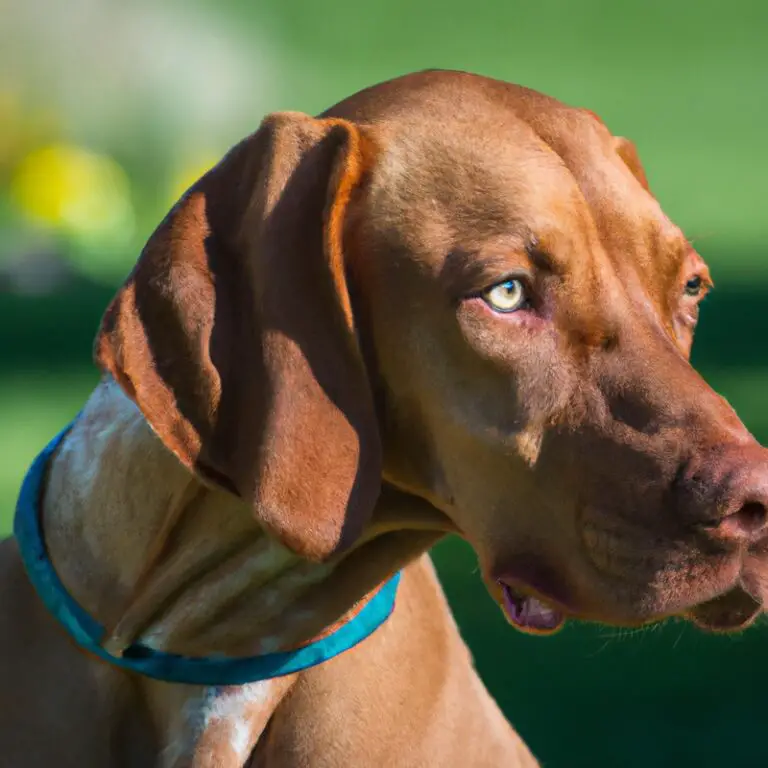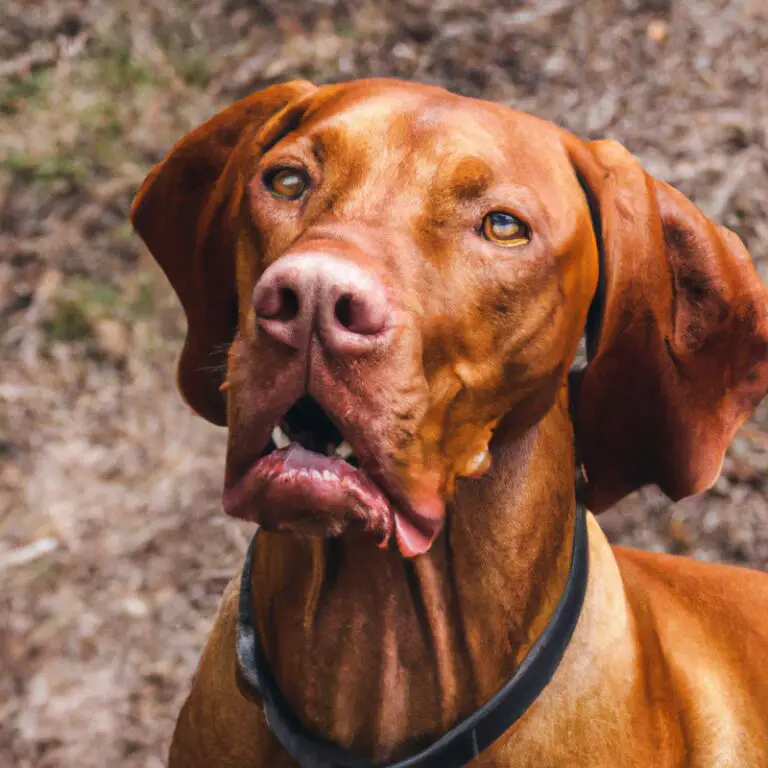How Do I Teach a Vizsla To Behave Calmly When Visitors Arrive?
Key Takeaways:
- Consistency is key when training your Vizsla to behave calmly around visitors.
- Gradually expose your Vizsla to different types of visitors to help them become more comfortable.
- Reward positive behavior to reinforce calm behavior during visitor arrivals.
- Patience and repetition are essential when training your Vizsla to behave calmly with visitors.
Have you ever wondered why your beloved Vizsla transforms into a whirlwind of energy whenever visitors cross your doorstep?
Trust me, you’re not alone.
As a fellow Vizsla owner, I understand the struggle of wanting a well-behaved and calm pup when guests arrive.
But fear not! In this article, I will share valuable insights and proven techniques to help you teach your excitable Vizsla some manners.
From understanding the breed to preparing your pup for visitors and implementing effective training techniques, we’ll cover it all.
So, let’s dive in and unlock the secrets to a more peaceful and welcoming home.
| Issue | Solution |
|---|---|
| 1. Jumping on visitors | – Teach your Vizsla a “sit” or “down” command and reinforce it consistently – Use positive reinforcement to reward calm behavior – Redirect their energy with a toy or treat |
| 2. Barking excessively | – Train them to understand a “quiet” command and reward quiet behavior – Use positive reinforcement for calm behavior – Provide mental and physical stimulation to prevent boredom |
| 3. Nervous or fearful behavior | – Gradually expose your Vizsla to visitors and new situations – Use counter-conditioning and desensitization techniques – Seek professional help if the problem persists |
| 4. Hyperactivity | – Provide regular exercise and mental stimulation – Implement consistent training and reinforce calm behavior – Use interactive toys or puzzles to engage your Vizsla’s mind |
| 5. Jumping on furniture | – Teach your Vizsla a “place” or “off” command consistently – Use positive reinforcement and reward them for staying off furniture – Provide comfortable alternative spaces like dog beds or mats |
Understanding the Vizsla Breed
Characteristics of Vizslas
Vizslas are an energetic and active breed known for their friendly and affectionate nature.
They thrive on human companionship and make excellent family pets.
Vizslas are highly intelligent, easy to train, and excel in various activities such as obedience, agility, and hunting.
With their short coat, they require minimal grooming.
However, their high energy levels need to be regularly exercised to keep them calm and content.
Vizslas are also known to have a strong hunting instinct, so supervision is necessary when interacting with other small animals.
Their loving and loyal nature makes them a wonderful addition to any household.
Typical Vizsla Behavior
Vizslas are energetic and friendly dogs known for their loyalty and affection towards their family.
They are highly active and require plenty of exercise to keep them happy and healthy.
As hunting dogs, Vizslas have strong instincts and may exhibit behaviors such as chasing small animals or birds.
They are also known to be a bit “velcro dogs,” meaning they love to be close to their owners and may follow them around the house.
Socialization is crucial for Vizslas to prevent any excessive shyness or aggression towards strangers.
With consistent training and mental stimulation, Vizslas can learn to behave calmly when visitors arrive.

The Importance of Training
Establishing Leadership
Establishing leadership with your Vizsla is essential for creating a well-behaved and calm dog. Here are a few tips:
- Be consistent in your rules and boundaries. Vizslas thrive on consistency, so make sure everyone in your household enforces the same rules.
- Set clear expectations. Vizslas respond well to clear communication, so be assertive but fair when giving commands or corrections.
- Use positive reinforcement. Reward good behavior with treats, praise, or playtime to reinforce your role as the leader.
- Provide structure and routine. Vizslas benefit from a predictable schedule, so establish consistent feeding, exercise, and training times.
- Be confident and assertive. Vizslas are intuitive and can sense if you lack confidence. Show them you are in control without being aggressive.
By embodying strong leadership qualities, you can create a harmonious environment for your Vizsla and ensure they respond positively to visitors.
Consistency and Positive Reinforcement
Consistency and positive reinforcement are key when teaching a Vizsla to behave calmly when visitors arrive. By consistently enforcing rules and expectations, you establish clear boundaries for your dog.
Positive reinforcement, such as treats and praise, helps reinforce desired behaviors.
Remember to be patient and consistent in your approach, and avoid punishing or scolding your dog, as this can create confusion and anxiety. With time and practice, your Vizsla will learn to greet visitors calmly and politely.
Preparing Your Vizsla for Visitors
Desensitization to New People
Desensitization to new people is an important part of teaching your Vizsla to behave calmly when visitors arrive. Here are some tips to help you with this process:
- Start slow: Begin by introducing your Vizsla to one new person at a time, in a controlled environment.
- Positive associations: Pair the presence of the new person with something pleasant, like treats or playtime, to create a positive association.
- Gradual exposure: Gradually increase the duration and proximity of your Vizsla’s interactions with new people, while ensuring they stay calm and relaxed.
- Respect boundaries: Teach your Vizsla to respect personal space and greet people calmly. Reinforce good behavior and redirect any unwanted excitement.
- Consistency and patience: Consistent training and patience are key. Take small steps, celebrate progress, and address any setbacks with kindness and understanding.
Remember, every dog is unique, so adjust these tips to fit your Vizsla’s individual needs. With time and practice, your Vizsla can become more comfortable around new people.

Socialization and Exposure
Socialization and exposure are key for teaching a Vizsla to behave calmly when visitors arrive. Here’s how you can do it:
- Introduce your Vizsla to different people, places, and situations from an early age.
- Arrange play dates or visits with well-behaved dogs to encourage positive social interactions.
- Gradually expose your Vizsla to various environments, such as parks, cafes, and busy streets.
- Reward good behavior during socialization and exposure experiences to reinforce positive associations.
- Consistency is key, so continue providing opportunities for your Vizsla to socialize and be exposed to new things throughout their life.

Introducing Visitors to Your Vizsla
Using Safety Measures
Using safety measures when introducing visitors to your Vizsla is essential.
Here are some simple steps you can take to ensure a safe and calm environment:
- Before guests arrive, create a safe space for your Vizsla, such as a separate room or crate.
- Use a baby gate or leash to prevent any potential jumping or rushing towards the door.
- Teach your Vizsla basic obedience commands, like “sit” or “stay,” to help maintain control.
- Encourage visitors to ignore your Vizsla’s excited behavior, rewarding calm behavior instead.
- Gradually introduce your Vizsla to new visitors and work on desensitization techniques.
Remember, safety is key when introducing visitors to your Vizsla, so take your time and be patient throughout the process.
Controlled Introductions
Controlled introductions are important for teaching your Vizsla to behave calmly when visitors arrive. Start by keeping your dog on a leash to maintain control during the introduction.
Allow your Vizsla to approach the visitor calmly, rewarding good behavior with treats and praise.
Gradually increase the level of interaction as your dog remains calm. Remember to set clear boundaries and provide positive reinforcement to help your Vizsla learn appropriate behavior around visitors.
Training Techniques for Calm Behavior
Teaching Basic Commands
Teaching your Vizsla basic commands is an important part of their training.
Here are a few tips to help you out:
- Start with simple commands like “sit” and “stay.” Use treats or praise as rewards.
- Keep training sessions short, around 5-10 minutes, to avoid overwhelming your dog.
- Use consistent and clear verbal cues and hand signals.
- Practice in a quiet and distraction-free environment at first, then gradually introduce more distractions.
- Be patient and positive, rewarding your dog for correct responses.
- Gradually increase the difficulty of the commands as your Vizsla becomes more proficient.
Remember, training takes time and consistency, so be patient and enjoy the process of teaching your Vizsla.
Implementing Distraction Training
Implementing distraction training is a key strategy to teach your Vizsla to behave calmly when visitors arrive.
The goal is to redirect their attention away from the excitement and focus on a specific task or command.
Start by gradually introducing distractions during training sessions, such as knocking sounds or doorbells.
Reward your dog for staying calm and following commands.
Consistency is crucial, so practice regularly and gradually increase the difficulty level of distractions.
With patience and consistency, your Vizsla will learn to stay calm and interact politely with visitors.
Managing Visitors’ Arrival
Setting Expectations with Visitors
Setting expectations with visitors is essential for teaching your Vizsla to behave calmly.
- Remind visitors to ignore your dog until they are calm and settled.
- Ask them not to pet or make eye contact until your dog is calm.
- Set boundaries by using baby gates or keeping your dog in a separate room at first.
- Give your dog time to adjust and gradually introduce visitors in small, controlled interactions.
- Reward calm behavior and redirect any jumping or excessive barking.
- Consistency is key – ensure all visitors know and follow these rules.
Utilizing a Safe Space for Your Vizsla
Creating a safe space for your Vizsla is essential for their well-being. Give your dog a designated area where they can retreat to when visitors arrive.
Consider using a crate, a specific room, or a comfortable bed.
Make sure this space is quiet and away from the commotion. Provide your Vizsla with toys, water, and a cozy blanket to make them feel secure.
Introduce this safe space early on and gradually increase the duration of their stays.
This will help your Vizsla associate the safe space with positive experiences.
Common Challenges and Solutions
Jumping on Visitors
Jumping on visitors can be a common challenge with Vizslas.
To address this behavior, start by teaching your Vizsla a solid “off” command.
Practice this command during daily training sessions, gradually increasing the difficulty by adding distractions.
Consistency is key: reinforce the off command every time your Vizsla jumps on someone.
Consider having your Vizsla on a leash or using a baby gate to prevent jumping when visitors arrive.
Reward calm behavior and provide alternative outlets for their energy, such as mental and physical exercise.
With patience and consistent training, your Vizsla can learn to greet visitors calmly.
Excessive Barking
Excessive barking can be a common challenge with Vizslas when visitors arrive. To address this issue, you can try the following solutions:
- Teach the “Quiet” command: Start by using a command like “Quiet” or “Enough” when your Vizsla barks. Reward them when they stop barking. Consistent practice will reinforce the desired behavior.
- Desensitization: Gradually expose your Vizsla to different situations and people that typically trigger excessive barking. Start with low-stress scenarios and reward them for staying calm. Increase the difficulty over time.
- Provide mental and physical stimulation: Vizslas are an active breed that requires plenty of exercise and mental stimulation. A tired dog is less likely to exhibit excessive barking. Regular walks, training sessions, and puzzle toys can help keep them engaged.
- Seek professional help: If the problem persists, consider consulting a professional dog trainer or behaviorist. They can provide personalized guidance and techniques to address your Vizsla’s specific barking issues.
Remember, consistency and patience are key when training your Vizsla. With time and effort, you can help them behave calmly when visitors arrive.
Frequently Asked Questions
Can Vizslas be trained easily?
Vizslas can be trained fairly easily due to their intelligence and eagerness to please.
Their high energy levels may require more effort in terms of exercise and mental stimulation, but with consistent positive reinforcement and patience, they can quickly learn commands and behaviors.
It’s important to start training early and be consistent in your approach to establish good habits.
Remember to make training sessions fun and rewarding to keep your Vizsla engaged and motivated.
How long does it take for a Vizsla to learn to behave calmly when visitors arrive?
Teaching a Vizsla to behave calmly when visitors arrive is a gradual process. The timeline for learning can vary depending on the individual dog and their training history.
It usually takes a few weeks to a few months for a Vizsla to learn and apply the desired behavior consistently.
Consistent training, positive reinforcement, and patience are key. It’s important to remember that each dog is unique, so the learning process may take longer for some dogs than others.
The key is to stay consistent and persistent in your training efforts.
Final Verdict
Teaching a Vizsla to behave calmly when visitors arrive requires understanding the breed’s characteristics and behavior, as well as consistent training techniques. By establishing leadership, using positive reinforcement, desensitizing to new people, and implementing distraction training, you can effectively prepare your Vizsla for visitor interactions.
Introducing visitors to your Vizsla safely and managing their arrival with clear expectations and a designated safe space are essential.
While challenges like jumping and barking may arise, solutions and training strategies can be implemented. Overall, with patience, consistency, and proper training, your Vizsla can learn to greet visitors calmly and make everyone’s experience enjoyable.







